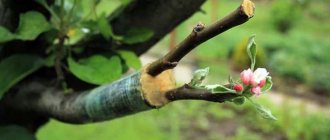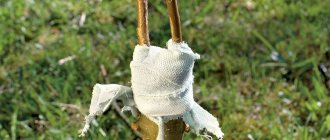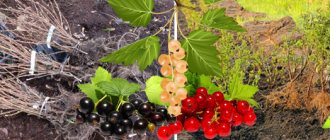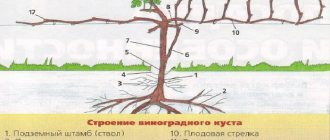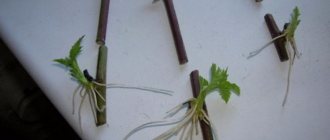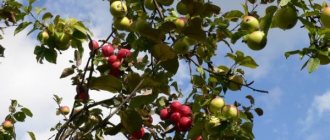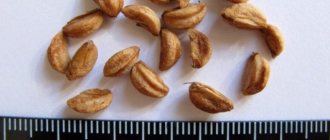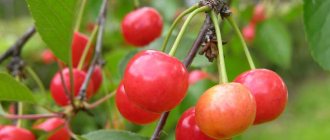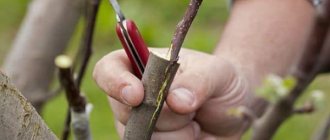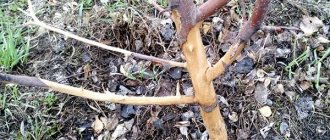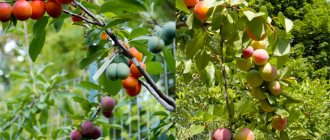Spring grafting, grafting an apple tree with cuttings in the spring onto an old, mature tree, an old mature apple tree.
Tree grafting is a vegetative method that allows trees to propagate. Almost all trees can be grafted, including apple trees. Over time, each apple tree becomes old, produces little fruit, and the fruits decrease significantly. In order to prevent the aging of the apple tree and preserve the fruits, it is necessary to graft the tree. How to properly graft an apple tree? Read about it below.
Grafting apple trees in spring for beginners: methods
With the help of grafting, you can increase the lifespan of the apple tree, plus you will get an excellent harvest. If you do not have a very large garden, then you can save the day by grafting. And all because it is recommended to graft several species onto one apple tree at once, or add branches of other trees, for example, pears.
Having followed all the rules, you will end up with a tree, thanks to which you will collect not only apples, but also other types of fruits. Also, using this method, you will propagate apple trees of the variety you need and rejuvenate the old tree.
Grafting an apple tree has its main advantages:
- The fruits begin to ripen much faster.
- Thanks to grafting, other types of apple trees can be developed.
- The tree's immunity increases significantly, after which the apple tree is able to withstand many negative influences of the external environment.
- After grafting, the crown is renewed, plus resistance to severe frosts increases.
- And most importantly, thanks to grafting, you can get a wide variety of fruit varieties in a very small area.
Grafting apple trees
There are several types of grafting. We will highlight the most important ones:
- Standard vaccination. As a rule, this type is used for young apple trees.
- Into the cleft The method allows you to obtain an increased percentage of tree survival, therefore, it is considered the most common among gardeners. Thanks to this species, you can graft a young cutting onto an old tree or get a new variety by grafting a mature branch.
- Budding. In this method, a bud is grafted, which is taken from another tree.
- Grafting in the side cut. In this method, grafting is carried out into the side cut of the tree bark. As a result, both parts grow together faster.
- Grafting using a grafting pruner. It is advisable to vaccinate in mid-spring.
- Ablactation. Suitable for saving a tree that is damaged. It is carried out in May, the scion is applied to the rootstock using the method of rapprochement.
What trees can an apple tree be grafted onto?
Having become familiar with the grafting methods, it is worth considering the crops on which an apple tree can be grafted, which in some cases can be quite important.
To the pear
The general rule of grafting is the following: closely related crops are characterized by good fusion, that is, an apple tree takes root best on an apple tree than on the same pear or other trees. At the same time, many gardeners quite successfully graft an apple tree onto a pear tree, and in different ways (into a split, behind the bark).
Video: grafting an apple tree onto a pear
To the mountain ash
Despite the fact that the apple tree does not always take root on the mountain ash, many continue to practice and even improve this method. And there is a logical explanation for this, since rowan as a rootstock has:
- frost resistance;
- unpretentiousness to soils;
- the quality of the fruit does not deteriorate.
In addition, it is possible to obtain an earlier and more abundant harvest, since rowan is used as a weak-growing rootstock. Since it ripens in early September, the varieties of apple trees need to be selected accordingly. You can, for example, graft Belfer-Chinese or Long (Chinese).
Grafting an apple tree onto a rowan tree allows you to increase the frost resistance of the tree without losing the quality of the fruit.
Grafting an apple tree onto a plum tree
Although it is generally accepted that pomaceous plants should be grafted onto pomaceous plants, and stone fruits onto stone fruits, experiments indicate possible exceptions. There have been cases when gardeners, due to confusion, grafted an apple tree onto a plum tree. After discovering the error, they were surprised that the graft took root and began to grow. Since apple and plum trees belong to the Rosaceae family, such splices take root. However, purposefully using a plum as a rootstock is a questionable undertaking. The fact is that a plum tree has a short lifespan compared to an apple tree. In addition, an apple shoot is usually thicker than a plum shoot, which leads to breakage at the grafting site. And there is no data on the harvest. Therefore, successful grafting does not yet indicate a future harvest.
To the cherry
Cherry also belongs to the Rosaceae family and grafting an apple tree onto it is quite possible. But, as with plums, the further development of the grafted cuttings is quite problematic. The likelihood that the cherry tree will reject the graft is high. It is unknown how long this will take. Most likely, it will not be possible to obtain a harvest with this combination. The cherry tree simply cannot withstand the apple tree branches. Sweet cherries in this regard are even more whimsical than cherries.
On the hawthorn
Hawthorn as a rootstock for apple trees is attractive because the plant is low-growing. Grafting can be done with cuttings up to 50 cm long at a height of 50–60 cm from the ground, and by autumn you can obtain a well-developed seedling. Thanks to this splicing, it is possible to accelerate the entry of the apple tree into fruiting by a year or more. The fusion is quite strong and without any defects. Another positive quality of hawthorn is that the plant has a root system that is located closer to the surface of the earth. Therefore, it can be used for planting fruit trees in areas with high groundwater levels.
Video: hawthorn grafting
In Irgu
Irga is known as a dwarf rootstock on which apple and pear trees can be grafted. For long-term growth, it is better to graft at a height of 15–20 cm from the ground. If the place of merging is higher, you need to take into account that the shadberry has flexible and thin branches. Cultures will develop unevenly. In addition, you will need to place supports under the apple tree branches to avoid breaking.
Irga is used as a dwarf rootstock for apple and pear grafting
To quince
An apple tree can be grafted onto a quince only as an experiment, since the likelihood that the cutting will take root well and begin to bear fruit is not very high. In most cases, after 3–5 years, the grafted part simply dies.
To the birch
Sometimes you can hear information about grafting an apple tree onto a birch tree. The result of such crossing will most likely be negative, although I.V. Michurin himself succeeded in this. At the same time, it is worth considering whether such a vaccination is necessary even as an experiment. After all, birch is a tall tree and it will be very difficult to get fruits, if any grow.
To viburnum
Despite the fact that the viburnum rootstock gives the apple tree winter hardiness, the fruits may become smaller.
Video: grafting apple tree cuttings onto viburnum
To the aspen
The splitting of an apple tree with aspen, bird cherry and sea buckthorn can only be carried out for the purpose of experiment. Even if the cuttings take root, their viability will be low and one cannot count on any results.
Grafting apple trees in spring for beginners: which month is better, timing
Theoretically, you can graft an apple tree at any time of the year. Here everything will depend on the climate of the area and the grafting method.
Spring grafting
Spring is the most ideal time of year when you can vaccinate. After all, after the sap begins to move inside the tree, the scions take root better.
- It is advisable to graft an apple tree using cuttings in early spring, from March to April. It is at this time that the frosts should end.
- Spring vaccination has its own advantages. For example, if your scion does not take root, you can graft the tree in the summer without losing a year.
Summer vaccination
From July to August, fruit trees begin to actively produce sap again. Therefore, for this period of the year, budding using a “sleeping” eye is suitable. In the southern regions, it is with the help of this method that apple trees are grafted from August to September.
Plant an apple tree in spring
Autumn vaccination
In the fall, professional gardeners do not recommend vaccination. But, if the weather permits in September, you can graft using the “eye”.
For September and October, other grafting methods are suitable. For example, in the cleft. It is worth considering that young rootstocks take root well in the fall. But grafting will cause harm to an adult apple tree.
Winter vaccination
This grafting is only suitable for trees that grow indoors. Hence, it is called “table grafting”. Using this method, you can graft seedlings for spring planting.
- Tree seedlings, as a rule, are grafted from the beginning of winter to March.
- Grafting will be successful if the rootstocks are stored properly in winter. Keep seedlings with cuttings in a cool place where the temperature is approximately 0 degrees.
When is the best time to graft an apple tree?
The most favorable period is spring. Grafting with cuttings begins in March - April. The apple tree is grafted with buds or eyes in April - early May.
The best period is when the buds have not yet blossomed, but sap flow has already begun. The procedure is performed on a cool, cloudy day.
Advantages of spring vaccination:
- the ability to repeat the procedure in the summer without wasting time until next spring if the scions did not take root for a number of reasons;
- elimination of cultural defects;
- correction of underdeveloped trunks;
- restoration of a one-sided crown;
- resuscitation of damaged trees;
- breeding hybrid and dwarf varieties;
- increasing plant immunity;
- preservation of taste and external characteristics of the variety.
Favorable time according to the lunar calendar
Grafting of fruit trees is carried out during the waxing moon. This improves varietal qualities and increases the endurance of the crop. Gardeners recommend carrying out the procedure on fruit days, closer to the full moon, when the Moon is in Aries, Leo and Taurus. The growing Moon directs the sap and strength of the plant into the new shoot, which helps it take root faster.
Apple tree grafting calendar for 2021:
- March - 1-4, 6, 8, 26, 29;
- April - 2, 5, 7, 24, 25, 30;
- May - 1, 2, 6, 15-17, 27, 29.
Apple tree grafting calendar for 2021:
- March - 4, 12-14;
- April - 1, 3-5, 8, 9, 13, 14, 19, 25, 26, 28;
- May - 2, 5-7, 12-17, 21, 22, 24-26.
How to make a graft and prepare an apple tree for grafting: description
Do you have several apple trees in your garden, but are you getting little fruit from them? Therefore, you can graft the plants. How to properly prepare an apple tree and how to graft?
- For this job you will need a well-sharpened knife. Vaccination is similar in complexity to a surgical operation, so be extremely careful and don’t miss a single detail. Decide from the very beginning exactly when you will get vaccinated. If you decide to graft in the spring, then choose a method using a cutting from another tree. But in the summer you can safely graft an apple tree onto a bud.
- Prepare the cutting after the first frost has passed. Use a sharp knife while working. Use it to cut off a young branch that grows upward. Make the cut so that it is 3 times the width of the branch. Remove the top of the cutting. You should end up with a cutting that is 30 cm long. Store the cutting in a cool place, immerse it in a box filled with sawdust or sand.
- In the spring, after the buds swell, prepare the cuttings. Wash your hands thoroughly before working. Cut a branch of the apple tree so that the cut is the same as the rootstock. Do this immediately before the main work. Place the oblique cuts next to each other. This way they will grow together faster.
Apple scion
- If the diameter of the branches is not the same, then use the “bark” method.
- It doesn't matter which vaccination method you decide to choose. Most importantly, make sure that the edges of the scion and rootstock are in close contact.
- Never use electrical tape for work. Since there is glue on it, the scion will not grow to the rootstock. Use plastic film, wrap it around the graft and apply oil paint or drying oil over it. Apply the graft several times and loosen the bandage after a couple of weeks. After the buds open, you can safely remove the bandage.
Preparation of cuttings
Before starting to take cuttings, novice gardeners should remember the basic terms used by experienced colleagues.
| Term | Designation |
| Scion | Material taken from a plant that will be grafted onto another tree. A scion can refer to a bud, cutting, or shoot. |
| Rootstock | The plant to which the scion is attached. |
| Copulation | The grafting method uses cuttings of the same thickness. |
| Budding | Engraftment method using one kidney. |
An important point when preparing cuttings is the selection of a suitable tree. It should be more than a year old, strong, with a good yield. Sprouts of healthy apple tree branches about 3.5 cm long are used as scion.
A cut is made on the lower edge at an angle of 45°, the length of which should be 3 times the diameter.
When preparing and storing, the following rules are followed:
- it is better to carry out the procedure in the second half of autumn - from the end of October to the middle of November;
- when frost occurs, long annual shoots with 3-4 medium-sized buds are cut off from the middle part of the branches;
- The prepared cuttings are tied into bunches, rolled into damp natural fabric or covered with sand or sawdust.
The optimal storage temperature for cuttings is +2°C. The material can be stored in the basement, refrigerator or under snow cover.
If the blanks have started to grow or become moldy, then they cannot be used for scion.
Grafting apple trees in spring for beginners with grafting pruners: description, video
With the help of a grafting pruner, you can make a high-quality grafting of a tree, even without much experience. It is advisable to carry out the vaccination process using this method in April, or even later, but not earlier.
A pruner is a simple and affordable tool. Therefore, you can easily do the job:
- Using pruning shears, make a cut on the rootstock.
- Make a cut on the scion as well. Make sure that the shape of the cut is the opposite of that of the rootstock.
- Connect the joints, then treat them with varnish.
- Wrap the joint with twine, or you can also use a special film.
This method is suitable for cuttings whose length is no more than 13 cm. As a rule, grafting pruners have spare attachments that can be changed. When deciding which pruning shears to buy, pay attention to models that have a ribbon spring and a blade.
Vaccination rules
Grafting is the transplantation of one fragment of a plant to another. The basis is taken from the properties of cultures to heal their wounds and grow together. To increase the survival rate of vaccinations, you need to follow simple rules:
- Each method has its own time period. For example, budding is used only in the spring, but copulation is done at any time of the year.
- It is necessary to use sharpened tools, such as garden saws and knives, pruning shears.
- Transverse sections of branches made on the rootstock should be trimmed with a knife.
- The movement of the knife when making a cut on rootstocks and cuttings should be towards you.
- You should try to make the cut once without additional editing.
- Fatty discharge from the gardener's fingers has a bad effect on the survival rate of cuttings, so it is better not to touch the cuttings with your hands.
- The time between inserting the cutting and the moment it is tied should not exceed a maximum of three minutes.
- After finishing the bandaging, open wounds must be coated with garden varnish.
- When preparing a tree for regrafting, thick branches are cut down from 30 cm to 50 cm above the site of the intended operation, and then the final cut is made.
- The ends of the rootstocks are cleaned with a knife before inserting the scion so that the tissue on the saw cuts does not oxidize.
- Re-grafting is always done from top to bottom: it does not disturb the lower grafts during work.
When working with a sharp instrument, you must strictly observe safety precautions, follow all instructions, prepare the grafting material and carry out the grafting in various ways.
Grafting apple trees in spring for beginners into cleft step by step: diagram, description
For grafting, take a cutting that is about 2 times larger than the size of the rootstock. Next, perform the following manipulations:
- Cut down the branch using a sharp hacksaw. From the bend, the size of the branch should be 15 cm, if from the trunk, then the size should be 30 cm.
- Split the branch lengthwise in the central part or on the side. It all depends on the thickness of the branch itself.
- Prepare the cuttings in advance, it is better to take a couple of cuttings. Leave 3 buds on the cutting and make a wedge cut on it. The length of the size should be 3 cm.
- It is ideal for the branch to have hangers or ledges.
Reproduction
- To make working with thick branches more comfortable, take a wedge.
- Insert the cutting into the place where it matches.
- Using a varnish, treat all joints.
- Wrap the film very tightly around the joint.
- If you get several vaccinations, after a certain time, keep the one you think is the best.
This method allows you to obtain excellent survival rates over time. With the help of such a grafting, you can place a young branch next to an adult tree. Use the method in spring, around April.
Step by step instructions
There are many different methods of grafting fruit trees. The most tested, showing the best results:
- copulation;
- grafting into cleft.
In addition to this, other techniques are widely used, less common, but also bringing good results:
- in a side section;
- for the bark;
- in a stump;
- to the root;
- bridge.
Before you begin the manipulation, keep in mind that this is an “operation”, before starting which you need to wash your hands, disinfect the instrument and try to touch the cut areas as little as possible.
Copulation
The word "copulation" comes from the Latin word copulo, which means fusion, connection. In horticulture, it is used to designate the fusion of a rootstock and a scion of the same thickness. The point of copulation is to combine the rootstock and scion into one branch.
There are two types of copulation:
- simple - used on young apple trees. A rootstock is prepared, the age of which is from 1 to 2 years, with a maximum thickness of 1.5 cm. The scion is selected in accordance with the thickness. The cuts of the rootstock and scion are made at the same angle;
- improved, differing from simple copulation by an additional incision - a tongue. It is cut on the cuttings and rootstock.
To perform advanced copying you will need:
- Make oblique cuts of the same length from 2 to 4 cm on the rootstock and cuttings.
- Make cuts - tongues. The fusion will be stronger if the cut is long.
- The handle is wedged into the tongue, pressed tightly with your fingers.
- The grafting site is wrapped with plastic film, electrical tape or cloth.
- The treatment is carried out using garden varnish.
The effectiveness of this method depends on the coincidence of joining the cambium layers of two plants. Due to the fact that it is quite difficult to ideally combine the cambial layers, gardeners use improved copulation technology.
Grafting into cleft
The best option for grafting seedlings aged from 3 to 5 years is the split grafting method. The procedure is carried out in the skeletal branch in early spring from March to April. The procedure is as follows:
- The rootstock must be split with an ax to a depth of 8 to 10 cm.
- At the lower end of the scion, a cut is made at an angle so that its length coincides with the depth of the split. Using a knife, make a one- or two-sided cut.
- If the circumference of the cleft exceeds the diameter of the scion, then 2 to 4 rootstocks are installed in the cleft.
- For fixation use twine or fabric.
- The grafting site is treated with garden varnish.
The effectiveness of this method is almost 100%, especially if you choose the timing of the “operation” wisely.
Side cut
Grafting into a side cut is considered the simplest method, which even a novice gardener can easily cope with. To do this, you only need a sharp garden knife. You must proceed as follows:
- A lower cut is made on the cutting at an angle of 45°.
- On the rootstock plant, select a branch where the cutting will be implanted, and make an indent of approximately 20 cm from its base.
- The tree bark is cut at an angle of 20°, cutting the wood a few millimeters inward.
- The lower edge of the cutting is inserted into the cut on the rootstock, achieving a tight fit.
- The grafting site is tied with polyethylene and coated with garden pitch.
This scheme is suitable when there is a need to rejuvenate and heal old trees. The most optimal time for this is in the second half of spring, when the sap flow process has started.
For the bark
This grafting option is the best way for adult plants that need to be made more frost-resistant and strong. Excellent for acclimatization of heat-loving varieties.
You should proceed step by step as follows:
- Four cuttings can be grafted onto a rootstock at once. Then three are removed, leaving the particularly strong one.
- Using a sharp knife, make a cut 4-5 cm long and 100 cm high from the soil.
- By pushing back the bark, the wood is slightly exposed.
- An oblique cut is made on the scion in the lower part, the length of which should correspond to 3 diameters of the scion.
- Having brought the cutting behind the bark, press it tightly, tying the place with polyethylene or cloth.
- The grafting site is lubricated with varnish.
The process is quite complex and requires precision execution. The task can be complicated by the fact that it is often not possible to achieve maximum pairing of the rootstock. It is recommended to carry out the “operation” strictly in the spring during the period of sap flow, when it is easier to separate the bark from the wood.
On the stump
Sometimes a situation occurs when an old, poorly fruiting apple tree grows in a garden plot. After cutting it down, a living stump may remain. It can also be used as a grafting material.
The procedure is as follows:
- Prepare the stump in advance by refreshing the cut.
- Grafting can be done into the split or behind the bark.
- Carefully make 3-4 cm long cuts in the bark or make a split using an ax.
- Insert cuttings into cuts along the diameter of the stump from 2 to 4 cuttings.
- Press the bark tightly and wrap it with electrical tape.
- Treat the “operation” site with garden varnish.
To the root
If you manage to get a cutting of an unusual variety of apple tree, but there is nothing to vaccinate, then the root of the tree can come to the rescue. Apple trees often have roots located at shallow depths. It is recommended to do the procedure during the period when new buds appear. For this you will need:
- Make a cut on the root a meter from the trunk.
- Rinse it with running water and wipe with a rag, then clean it with a sharp knife.
- It is better to graft using the bark method.
- Tie the vaccination site with electrical tape or polyethylene.
- Coat the upper and lower parts of the cutting with varnish.
- To avoid stepping on the graft, fence off the grafting site with pegs.
By the bridge
Often used to save trees damaged by rodents over the winter. The procedure for bridge grafting is as follows:
- Clean the damaged area.
- Make cuts below and above the damage.
- Cut small cuttings, cut off the buds from them.
- Cut in one plane.
- Insert the cuttings into the lower cut with the lower part, and the upper part into the upper cut.
- Wrap the area with plastic wrap.
It is better to use several cuttings at the same time, this will increase the likelihood of saving the injured tree.
Grafting apple trees in the spring for beginners into the trunk step by step: diagram, description
This method is based on the following: a cut is made in the bark of the rootstock, as a result of which both parts grow together much faster. The method is used to rejuvenate the crown of the apple tree. The most ideal time is when the tree has not yet begun to produce sap and the buds on it have not begun to swell. As a rule, this happens around the month of April.
In order for your apple tree to give a good result after grafting, you must strictly follow these steps:
- Make a wedge at the bottom of the cutting. Cut both sides of the wedge to create an acute angle.
- Make a sharp cut on the side of the rootstock too. The length of this cut should correspond to the wedge on the scion. Try to cut off more wood along with the bark, but not much.
Fruit grafting
- Insert the cutting, lubricate the joint using garden varnish.
- Wrap film over the joint.
- Shorten the cutting by about 10 mm so that the cut is above the 2nd bud. Seal the cut using garden varnish.
Gardener mistakes
Grafting fruit trees is a rather labor-intensive process, complicated by various nuances. To avoid failures in apple tree grafting for beginners in the spring, the following points should be taken into account:
- The most common mistake is poor fit between the scion and rootstock. The healing process is often slowed down because of this, and the cuttings have time to dry out. This oversight can be corrected by carefully examining the cut location. It should be smooth without nicks or waves.
- Another mistake is poor sanitation and the use of dirty tools. The result is the penetration of harmful bacteria and parasites into the wood.
- After the procedure, it is necessary to carefully treat the injured areas with garden varnish.
- When copulating on a side cut, do not forget to take a cutting with a sufficient number of buds from 3 to 5 pieces.
- Use cuttings taken during the dormant period.
- Do not vaccinate during rain.
- Don't forget to remove the harness in advance.
- Do not leave shoots that have sprouted below the grafting site.
An inexperienced gardener should study all possible methods of grafting fruit trees and choose the most optimal option for himself. It is best to carry out manipulations in early spring, and if the first time you do not succeed in grafting the scion to the rootstock, then do not be upset, but try to repeat this action in the summer.
Spring grafting of apple trees is necessary for increasing productivity, renewing and rejuvenating old trees, growing several varieties on one tree, saving space on the garden plot, cultivating game trees, resuscitating injured apple trees, increasing frost resistance and immunity of plants. The event is best held from March to May, focusing on climatic zones.
If you know the rules and have some experience, you can learn to graft not only apple trees, but also other fruit trees - pears, plums, cherries, etc.
Grafting apple trees in the spring for beginners into stumps step by step: diagram, description
You may have encountered a situation where:
- There is an old apple tree in the garden, but it no longer bears fruit.
- There is an apple tree stump in the garden, but it is still alive.
Grafting into a stump
You can also use it to vaccinate.
- Prepare the stump in advance. If you don't have one, cut down an old apple tree or freshen up a cut you already have.
- Clean the stump carefully.
- Choose any grafting method.
- Take the cutting, prepare it, insert it into the existing cut.
- Wrap the correct area with film.
- Treat the area where the graft is located with varnish.
Think in advance about what is best to make protection for the stump so that it is not disturbed by animals and birds.
Grafting apple trees in the spring for beginners under the bark step by step: diagram, description
This method is used to graft a tree. The diameter of the branches allows you to place several cuttings at the same time. The method is used when active sap flow occurs in the tree.
So, you need to perform the following manipulations:
- Prepare several cuts in the tree bark at once.
- Make oblique cuts on each cutting, the length of which should be approximately 3 cm. Clean the back side of the cuttings in advance so that they match the cuts of the tree as closely as possible.
- Cut off the top of the rootstock. The cut should be above the kidney. Place the scion behind the tree bark.
- The top of the cutting should protrude 0.3 cm. Secure everything with a rope.
Grafting in the spring
It will take a very long time for the cuttings and the tree to grow together. During this period of time, constantly protect the branches to prevent them from breaking. Next year, leave the strongest branch untouched and shorten the remaining ones. After 3 years, remove excess branches.
Basic methods
Grafting of fruit crops in China was known back in the fifth millennium BC. And now more than 130 of its techniques are known in world practice. There are many ways to graft apple trees in the spring. They all differ in terms of completion time.
- Transplantation is carried out in the spring before the start of sap flow.
- Vaccinations that are performed only during the period of sap movement.
The branches taken for cuttings must be healthy and older than one year. It is better to cut them at the beginning of winter, when the air temperature reaches -10 °C. The cuttings should be stored at a temperature of -2 °C until spring. The branch should have 3 to 4 buds without damage. The upper cut is made obliquely, and the lower cut is made based on the type of grafting chosen. It is better to take the middle part of the branch.
Transplantation into cleft
The process of grafting into clefts does not require much preparation and does not take much time. It can be done in early spring. The best time is when the buds are swelling. The method has a high survival rate and is ideal for regrafting young trees.
Step-by-step instruction:
- A plant suitable for regrafting is selected.
- Using a clean rag, remove dirt and dust from the branch from the site of the intended cut to the trunk.
- Re-grafting begins with pruning the branches where the cuts are made.
- A split 3-4 cm deep should run along the diameter of the cross section of the rootstock.
- A cutting is inserted into the split. It is necessary to ensure that the bark of the regrafted branch coincides with the bark of the cutting on at least one side.
- To ensure rapid fusion of the branch and the cutting, a tight bandage must be applied to the grafting site.
- To prevent open wounds from drying out, they are covered with garden varnish. You also need to cover the upper end of the cutting.
- After two weeks, you need to inspect the pinched area and, if necessary, apply garden varnish again.
- After two months, the strapping must be carefully removed with a knife so that it does not cut into the bark.
Now you can wait for the fruits of the variety that the gardener wanted to have. For this method, it is important to choose the right vaccination site.
Grafting with germinating eye
The advantage of this method is that a new plant can be obtained from a bud, while all the properties of the selected variety are preserved. You can graft an apple tree very quickly in the spring, provided that there are good rootstocks. Sequencing:
- If the tree is healthy, a transverse cut of 2-3 mm is made on the rootstock.
- Stepping back from the cut up the branch by 3-4 cm, a plate is cut out to the transverse cut.
- A plate of the same shape and size as that cut on the rootstock is cut from a cutting of a healthy tree.
- The plate cut from the cutting is placed on the rootstock so that the edges of the cuts coincide with each other.
- The pinched area is carefully tied, and a garden varnish is applied on top.
Several such plates with a bud on one branch can be placed, if necessary. The bark at the grafting site should be smooth, even, thin and elastic, and the scion buds should be mature.
New variety on an old tree
In order to graft an apple tree onto an old tree in the spring, more stringent conditions are required than when regrafting young crops. First of all, mature trees must be frost-resistant, healthy and growing well.
It is better to spread the re-grafting of old apple trees over 2-3 years. In the first year, the branches of the lower tier are regrafted, and then the upper ones. It is better to take branches with a diameter of no more than 5-6 cm at the grafting site. Cuts of large diameter take several years to overgrow, and in severe winters they can freeze.
For regrafting mature trees, the lateral cutting and bark cutting methods are suitable, of which the first is the main one. The side cut involves the following steps:
- A side cut is made on both sides of the branch. A cutting is inserted into it so that its bark on the inside coincides with the bark of the branch.
- Since the diameter of the regrafted branch is large, a third cutting is grafted onto the bark using this method. To do this, the bark is cut down to the wood and a cutting is inserted into it.
- After installing the cuttings, a bandage is applied to the grafting sites, and the open parts of the cuts are covered with garden pitch.
How to do budding step by step: diagram, description
This grafting method is as follows: only a bud taken from another tree can be grafted onto the rootstock. For grafting in the spring, as a rule, a bud that was left last year is used. The most ideal time for work is April, the end of the month. At this time, the bark is already beginning to peel off, and the cambium is actively growing. Consequently, the scion will take root quite quickly.
Budding
Tree grafting using the budding method is carried out in the following sequence:
- Cut a bud from the main cuttings prepared in advance.
- Cut the bark of the rootstock at the internode in a "T" shape.
- Bend back the bark, drive the bud into the formed base.
- Lubricate the area with varnish and wrap it with twine.
What to graft on and preparing the tree for grafting
What is a rootstock?
Gardeners call the material on which the cutting will be grafted a rootstock . Often, summer residents graft the varieties they like onto wild apple trees - young twigs grown from an apple tree seed.
It is considered more correct to graft onto special clonal rootstocks for apple trees. They are created specifically for vaccination. Typically, clonal rootstocks for apple trees with different characteristics are designated by alphanumeric names (62-396, MM-106, 54-118, etc.).
It can be dwarf, semi-dwarf, medium-sized or vigorous material.
IMPORTANT! Not all apple varieties are well compatible with different rootstocks.
You can also regraft an adult tree or a young, but unsuitable seedling. In this case, grafting is usually carried out into a suitable skeletal branch.
How to choose rootstock for an apple tree Video:
What is a scion? A scion is a grafted cutting. For the scion you need to take one-year-old shoots. The cuttings for grafting are cut immediately before grafting. Usually this is a small section of a branch with 3-4 buds.
Healthy branches of one-year growth without signs of disease or damage to the bark are suitable for grafting.
Scion cuttings must be alive. This means that on the cut of the cutting you should see a green border, not a brown color.
When grafting, gardeners strive to ensure that the diameter of the rootstock branch and the diameter of the scion cuttings coincide, but most often when re-grafting already mature trees, this is impossible to achieve. Therefore, the gardener uses different grafting methods: bark grafting, split grafting, parasitic grafting and others.
How to make copulation step by step: diagram, description
The most difficult thing you will encounter using this method is cutting the rootstock. It must be done carefully, the first time. Hence, practice beforehand. Vaccination is carried out in April or early summer.
- Wipe the area where the cut of the rootstock will be located.
- Make a cut. You should end up with an acute angle towards you.
- Make an identical cut under the lower bud on the scion.
- Connect both parts.
Copying
- Fix the place where the connection is located, and apply an overlapping bandage.
- Cover the area with varnish, thereby protecting it from environmental influences.
Preparation of tools and materials
To perform grafting work, you will need a set of tools, the composition of which has not changed since the beginning of selection. This:
- A sharp knife and a hacksaw - they are used to make cuts. Use a hacksaw to cut down thick branches, if necessary. Before use, be sure to sharpen and treat with antiseptics - this will reduce injury and the risk of infection.
- Garden var. The grafted cuttings are treated with this composition to increase the chances of survival.
- Electrical tape or polyethylene - needed for tying and fixing the handle. With their help, the drive is also protected from bacterial infections and environmental aggression.
- Drying oil or paint suitable for wood processing. The cuttings are painted at the very end of the work.
The market offers gardeners a new toolkit - a grafting pruner. It is used by both professionals and novice gardeners. This type of pruner reduces the risk of injury to plants. Thanks to the special shape of the blade, the grafting pruner can make shaped cuts that improve the pairing of the cutting with the rootstock. The tool is designed for three different operations:
- making a cut with a groove for installing the cutting;
- cutting the handle to ensure its precise fit into the groove;
- performing budding.
To tie the graft, gardeners use electrical tape, plastic strips, twine and grafting tape. But the best material is cotton fabric soaked in garden varnish. It is recommended to use such a winding for the inner layer, and wrap the old bandage on the outside.
How to make an apple tree ablation step by step: diagram, description
Many gardeners use this method, using it to save a damaged apple tree. It is held in May, no later. To get excellent results, follow these steps:
- Make a cut on the scion and a cut on the rootstock. Please note that the resulting cuts must be identical. If necessary, you can remove a small layer of wood.
- Place the cuts next to each other, they must match.
- Lubricate the joint with var.
- Wrap with film.
Ablation
After some time, when the graft has grown together well, remove the winding and cut off the growth from the shoot. Then cut off a branch of the rootstock.
Caring for a grafted apple tree after grafting: description
- Do not remove old branches after grafting. This can weaken the roots of the apple tree.
- To protect the inoculation from birds, install the bar by covering it with colored tape.
- Constantly check the place where the cut is located, as well as the branch. If after 2 weeks the grafting cannot take root, remove the dried cuttings and treat the cut area with varnish. Feed the tree itself with fertilizers.
- If the grafting is successful, you will notice a thin cambium on the scion, plus new shoots. Remove the leaves so that they do not form a shadow for the grafting.
- After the grafting has taken root, prune it. Remove the lower shoot if you have at least 4 shoots on the scion. Trim those shoots that have formed on the side, almost to the skeletal branch of the tree itself.
- Have you noticed that the graft has begun to grow actively? Stop its growth by pinching off the tops.
- Tie the rootstock, which is 25 cm long, and point it upward so that it grows correctly. Make the next garter when the branch is 50 cm in size.
- For 2 years, water the grafted tree, especially in summer, and feed it. After 2 years, remove the ropes, ribbons and film.
